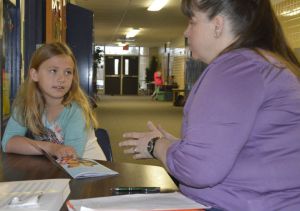Stephanie Lapinski knows Central Elementary School well, and not just because her children, Madeline and Nickolas, go to school there. She volunteers weekly in tutoring students, and helps with PTO book fairs and Popcorn Fridays.
So for her, the school district’s $55.24 million bond request on May 3 has a direct impact on her children’s education: by funding updated iPads and computers that don’t crash, classroom ceilings that don’t leak and safer bus drop-offs. But she thinks it’s also crucial voters approve the request for the good of the Kenowa Hills area as a whole.
|
ONE MORE TIME On May 3, Kenowa Hills voters are again being asked to approve a $55.24 million bond issue that was narrowly rejected in November. At approximately 0.99 mills, approval would cost the owner of a $100,000 home about $49.50 a year. Major expenditures over five years would include: Aging Facilities (65 percent of bond funds)
Safety and Security (22 percent)
Technology (13 percent)
For more info: go to the Kenowa Hills website Read about all school requests facing voters in May 3 election |
“I think the schoolsare what holds the community together,” Lapinski said. “This is a wonderful community. But everyone needs to support the school. If they don’t, people are going to leave.”
She is among those urging approval of the bond following defeats of two previous requests. An identical $55.24 million request was defeated in November by just 23 votes. That proposal had been pared down from a $78.6 million request turned down last May.
Proponents are hoping more previous “yes” voters go to the polls than last time, when an 18-mill operating renewal passed comfortably. They say the bond is urgently needed to improve safety and security, repair facilities, upgrade technology and replace aging buses. Without it, the district will face greater financial struggles and will be forced to keep pulling money from classrooms to replace buses and fix roofs, said Superintendent Gerald Hopkins.
“We cannot afford not to task our community for support,” Hopkins said. “Without additional funding, our class sizes will continue to get higher and non-essential programs and opportunities will be difficult to maintain at the current level.”
Saying No Can Cost Too
Since the November defeat, Hopkins added, the district has spent nearly $100,000 on equipment failures and roof leaks. That’s on top of $1.2 million in budget cuts for this school year, he said, largely due to state per-pupil funding that is less than in 2006-07. Yet if the 0.99-mill increase were approved, Kenowa would still have the lowest rate in the county, he said.
In the halls and classrooms of 665-student Central Elementary, the need is all too apparent to Principal Cherie Horner. She points to brown water stains in the ceiling tiles, the residue of roof leaks that sometimes require a water bucket in the library.
She points to a lab of pokey, outdated computers where, just as state testing began, all crashed and students had to restart. She also points to overcrowded classrooms that would be reconfigured under the bond. Kindergarten and first-grade classrooms would also get their own bathrooms.
“Children are our future,” Horner said. “If they are not able to compete with their peers with the same resources (as) other school districts, we’re not setting them up for a successful future.”
Most crucially, Horner says, the bond would make Central students safer: with new security vestibules that would require visitors to go into the office before entering the building, and separate drop-off/pickup areas for parents and buses, so students aren’t walking across a drive where vehicles are moving.
♥Keeping Kids Safe, Tech Current
Safety is also top of mind for Jason Snyder, principal of Alpine Elementary. It too would get separate drop-off/pickup areas for parents and buses, with a new parking lot in front leading into a security vestibule. As it is now, traffic is congested around a side door and most visitors walk through a long hallway before reaching the office, forcing teachers to lock their classroom doors, he said.
“That’s our No. 1 job for learning, is to keep kids safe,” Snyder said of his 375-student school.
At Alpine, the bond would also add a new gymnasium, replacing one that now doubles as a cafeteria and auditorium. That would provide more space for physical education, free up the cafeteria for study space and create room for kitchen equipment now crammed in the halls.
The bond’s technology funding would replenish Chromebooks and iPads outliving their four- to five-year life, boosting the district’s effort to provide every student with a device, Snyder said.

“People who may not have grown up with that technology may not see how integral to learning it is,” he added. “That’s how our kids are going to get prepared for the work force.”
Back at Central, Stephanie Lapinski said her daughter Madeline started using iPads in kindergarten. Now she’s in second grade and they’re wearing down, slowing lessons and forcing students to share devices. Technology must be upgraded if Kenowa’s kids are going to keep pace with today’s learning, she said.
“You need to know how to use those things because that’s how the world is changing,” Lapinski said. “If nothing is upgraded now, it’s just going to deteriorate further for them” in future grades.
She also worries about her children’s safety, and doesn’t like the fact they have had their buses break down on the road to and from school. She doesn’t like how crowded classrooms distract them from their work. And she wants all Kenowa students to have a first-rate education.
“They should feel proud” of their schools, she said. “But if they have subpar equipment and (budget) cuts, they aren’t getting the full experience of the opportunities that they could have.”
As for the chances of the May 3 vote, she said, “The community pulling together would be awesome.”
CONNECT









